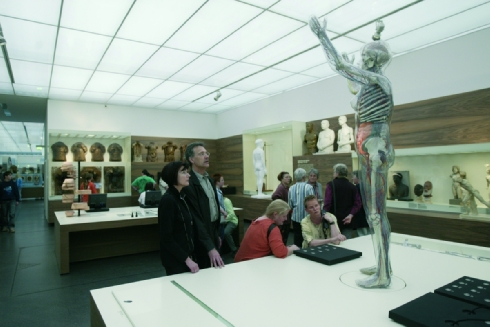Permanent Exhibition " Human Being - Body - Health"
From 2002 to 2004, the building has been refurbished and restored as far as possible to its original condition by the architect Professor Peter Kulka. The completely reconceived permanent exhibition (2,500 square meters of display space) presents an unprecedented range of valuable items from the museum's collection, including the Transparent Man and Transparent Woman, wax molds, and anatomical models. It also has numerous interactive learning elements and media installations for viewers to try out on their own. In addition, a museum for children has opened in November 2005.
In contrast to its narrow educational role during GDR times, the museum today aims to intrigue children, young people and adults about far more than simply the human body. It sees its task in making the human being accessible as a biological, psychological, social and cultural network through interdisciplinary exhibitions. The practice of cross-disciplinary activity between the natural and cultural sciences is observable today throughout the science landscape and portrays the human being in new unusual perspectives and a variety of contexts.
Marveling - Learning - Trying Out
In recent years, many special exhibitions on topics in the natural, cultural, and social sciences have repositioned the Deutsches Hygiene-Museum as a "museum of man." In 2004 and 2005, the museum gained yet another important dimension for its visitors when the permanent exhibition opened in two stages. Scientific developments, particularly those in reproductive medicine, brain research, and nanotechnology, pose new challenges for the museum, which until 1990 had focused on providing conventional information on health.
Lifelike, attractively designed classical exhibits and independent, hands-on learning have always been the salient strengths of this Dresden museum-and they still are in the permanent exhibition. Encompassing an area of more than half an acre, it presents over 1,300 objects, most of them from the museum's own collection. Items on loan from other institutions complement specially made media units and interactive displays to provide an informative and engaging museum experience. Addressing the vastly different needs of the visitors, this multifaceted approach to the topics treated in the exhibition has made the Deutsches Hygiene-Museum one of Europe's most interesting museums of science over the years.
The permanent exhibition revolves around a topic that is as obvious as it is demanding: the human being. There is no attempt to make its seven theme rooms encyclopedic. The aspects of human life they deal with are always anchored in the visitor's daily experience.
- THE TRANSPARENT MAN: Images of the Human Being Science
- LIVING AND DYING: From the Formation of the Cell to the Death of the Human Being
- EATING AND DRINKING: Eating as a Somatic Function and Cultural Achievement
- SEXUALITY: Love, Sex and Life Style in the Age of Reproductive Medical Science
- REMEMBERING-THINKING-LEARNING: The Cosmos of the Human Brain
- MOTION: The Art of Coordination
- BEAUTY, SKIN and HAIR: Open Boundaries between the Body and the Environment
The exhibition is conceived of as an adventure into one's own body, self, thoughts, and feelings. The range and juxtaposition of the objects achieve exhibition's ideal of any exhibition-they inspire the visitor's imagination and elicit reflection. The architecture of their presentation does not rely on spectacular scenographic effects but rather builds on the strengths of classical museum aesthetics.
The permanent exhibition was conceived of by a project team headed by Bodo Michael Baumunk. It was designed and built by the architects of Gerhards & Glücker, Berlin. Beginning in October 2005, an area offering hands-on experience for children will be added to this permanent exhibition.
The Special Exhibitions
Since the reopening of the Deutsches Hygiene-Museum and its completely new permanent exhibition in April 2005, all 2,500 square meters of display space have been available for changing special exhibitions, too. They are another focus of the museum's work and have contributed considerably to the Dresden museum receiving national attention. The exhibitions come into being through close co-operation between curators and scientific project groups as well as designers, artists, engineers, set designers and exhibition architects. They deal with the most up-to-date scientific research as well as everyday culture and analyse socio-political problems or philosophical and historico-cultural themes, as for example:
- "Darwin and Darwinism" (1994)
- "The Pill. Of Desire and Of Love" (1996)
- "Old & Young. The Generation Adventure" (1997)
- "Gene Worlds. Workshop Man?" (1998)
- "The New Human Being. Obsessions of the 20th Century" (1999)
- "Cosmos in the Head. Brain and Thinking" (2000)
- "The (Im-)perfect Human Being. The Right to Imperfection" (2000)
- "Sex. Facts and Fantasies" (2002)
- "Man and beast. A paradoxical relationship" (2002)
- "The Ten Commandments" (2004)
- "PLAY. The Exhibition" (2005)
- "Evolution. Tracing the Odyssey of Life" (2005/06)
- " Dresden - The Legend, A Cultural History Revue" (2006)
Education Program
The Collection
Service Facilities
The Deutsches Hygiene-Museum Foundation
Between 1991 and 1999, the museum was an administrative body of the Saxon State Ministry for Social Welfare, Health and Family. The following transition of the Deutsches Hygiene-Museum into a civil law foundation represented a great turningpoint, opening many new opportunities for development. The current standing of the foundation together with the participation of the Free State of Saxony, the Regional Capital Dresden, the Deutsche Krankenversicherung AG (as representative of private enterprise), as well as the option of the Federal Government, presents an innovative contemporary solution. Moreover, it incorporates the return to an organisational form of the museum which already existed in the 1920s.
Source: Deutsches Hygiene-Museum

